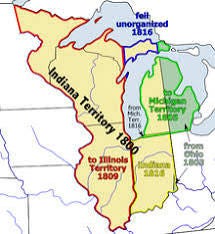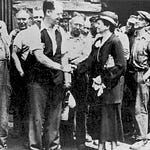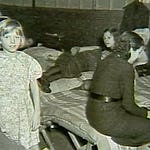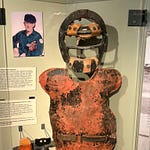I hope you’ve already read my last newsletter about Illinois’ Little Egypt, because this one builds upon it. We’re going to explore the region’s history with legalized slavery. As a reminder, Illinois and Indiana were once called the Illinois Country when first settled by the French, and it was the French who brought the first enslaved African workers there in 1720. The Illinois Country became part of the Northwest Territory in 1787, which meant it was bound by Article VI of the Northwest Ordinance: There shall be neither slavery nor involuntary servitude in the said territory otherwise than in the punishment of crimes whereof the party shall have been duly convicted. But slaveholders in the old Illinois Country (Illinois and Indiana) were exempted from the new law. Grandfathered, if you will.
Through the next ten questions, we’ll explore the history of slavery north of the Ohio River in what’s now Illinois and Indiana.
Note to my fabulous new subscribers:
It’s the rare person who can answer all ten trivia questions without any prep. I couldn’t answer them without a significant amount of research, either! Do your best and enjoy learning something new. Answers in the footnotes.
QUESTIONS
The French brought the first enslaved Africans to the Midwest around 1720 to work the mines along the Mississippi. The Illinois Country east of the Mississippi River became part of the Northwest Territory sixty-seven years later. Why didn’t Article VI end the practice of human bondage in the Illinois Country? In other words, on what grounds were the French enslavers granted an exemption from Article VI? More than one may apply.1
Slavery was never defined in Article VI.
Article VI didn’t contain an enforcement clause.
Article VI didn’t specify how to unwind slavery in places where it had taken root before the Northwest Ordinance of 1787.
The French enslavers cut a deal with Congress that they would phase out slavery within two generations using a plan modeled after Pennsylvania’s 1780 Act for the Gradual Abolition of Slavery.
In 1800, the Indiana Territory (which included Illinois) received its second territorial governor, William Henry Harrison. He had served as secretary of the Northwest Territory and was elected a territorial delegate to Congress, which means he knew that Article VI banned slavery. What action(s) did Harrison take in contradiction of Article VI? More than one may apply.2
He brought seven of his enslaved workers with him from Virginia to build his residence and gubernatorial office in Vincennes.
He enslaved Shawnee women to help run his household.
He purchased enslaved workers from French owners who had been in the territory. They built his residence and gubernatorial office in Vincennes.
After the Louisiana Purchase in 1803 (which involved land west of the Mississippi River), French slaveholders living in Illinois asked Congress to separate Illinois from the Indiana Territory and attach it to Louisiana, where they would have greater protection for their practice of human bondage. The French did not prevail. That same year, the Indiana Territory invented the loophole for prospective enslavers to bring their human property into the state using a practice known as chattel servitude. Instead of calling their human property “slaves” they called them “indentured workers.” Which of these is true about the “indentured servitude”contracts used in the Indiana Territory? More than one may apply.3
Indentured contracts could last for 90 years.
Holders of indenture contracts could sell the service contract, along with the worker, to another holder.
Children of indentured mothers were also considered indentured.
Enslaved workers who didn’t sign an indenture contract would be sold into bondage in slave states.
In 1803, “A Law concerning Servants,” in the Northwest Territory established some minimal requirements of masters toward their servants and formed the basis for regulating all slavery and involuntary servitude in the territory. Territorial Governor Harrison and the other white settlers conveniently assumed that all Black people entering the territory were voluntarily indentured before they arrived. This means they assumed that the states from whence the Black workers came had properly supervised these indenture contracts. Ha. How did Harrison et al justify the institution of slavery when appealing to Congress to override Article VI and allow outright slavery in the Territory? More than one may apply.4
Slavery would benefit the territory’s economy by stimulating settlement and increasing land values.
Allowing slavery in the Indiana Territory would keep slaveowners living in the Territory from moving west of the Mississippi River, where slavery was permitted by the French and Spanish.
Spreading the practice of enslaved labor throughout the West would benefit the captives themselves as well as the nation's white population, a belief known as diffusion.
A new theory that compared free labor, as practiced among workers in the American North and Great Britain, with slavery. This new theory claimed that because enslavers owned their workers, they took better care of them than the capitalists who merely rented theirs.
The Indiana Territory, which included Illinois, became a “second grade” territory in 1804. This meant Harrison governed with an elected territorial legislature (constituted of slavery proponents and slaveholders). Before the legislature had served a full month, the territory adopted “An Act concerning the introduction of Negroes and Mulattos into this Territory.” Is the following true or false?5
Under this law, a servant refusing an indenture contract (which could last 40-90 years) was cause for banishment into a slave state. With Kentucky on the other side of the Ohio River, the threat was easily executed.
One of the first major industries in southern Illinois was making salt from springs along the Saline River in Gallatin County. Located near the border of Kentucky, in the area known as Little Egypt, the salt operation profited from the labor of enslaved people sent into Illinois from southern states where enslavement was legal. In 1818, the salines became the property of Illinois. What happened to the institution of slavery when Illinois took over? More than one may apply.6
It went full steam ahead. After all, the saline business contributed a third of the state's revenue.
Illinois law only allowed enslaved Africans to be imported to the Saline River region until 1825, but enslavement persisted in the form of so-called indentured servitude.
In a major precedent, Illinois compensated the enslavers willing to sell their workers to the state, then put the workers on the state payroll as freedmen, but paid them less than workers of European descent.
In February of 1809, the Illinois Territory separated Indiana and Illinois, allowing the two entities to decide how to treat enslaved workers in a democratic manner. The two Indiana counties with the greatest support for slavery (Randolph and St. Clair) went with Illinois. What did the newly constituted Indiana legislature do regarding slavery and indentured servants? Choose wisely:7
Indiana repealed some of the territory’s proslavery legislation and prohibited the introduction of any new slaves or indentured servants.
Indiana chartered The Indiana Colonization Society. Based in Indianapolis, it advocated for the relocation of free people of color and emancipated slaves in Indiana to settlements in Liberia, Africa. The ICS was an auxiliary of the American Colonization Society, located in Washington, D.C.
Illinois Territory Legislation in 1813 prevented free Black people from immigrating there. As a result, free African Americans already living in Illinois had to register with the county clerk. The following March, the First Illinois General Assembly enacted a system of “Black Laws” limiting the rights of free people of color. What specific rights were limited by these Black Laws?8
They were required to register with the county clerk and provide a “Certificate of Freedom.”
Those who could not present a Certificate of Freedom were arrested—a kind of citizen’s arrest—taken to a justice of the peace, tried, and advertised as a runaway. If claimed, the white person who “arrested” them would receive a reward. If not claimed, they would be sold to into labor without pay (slavery) for up to one year. With this system of oppression, Illinois practiced a form of slavery until the Civil War.
Black people were prevented from offering testimony against a white person in a court of law.
The 1848 Constitution of Illinois did not permit slavery, but five years later, its approach to racial progress started to backslide. In 1853, the state legislature outlawed Black settlers in the criminal code. What was the penalty for Black people who remained in Illinois beyond ten days? Choose one:9
They could be arrested and fined. If they couldn’t pay the fines, they were auctioned off.
Men were sent to work in the salt mines for up to one year. Women and children were auctioned off.
Illinois’ Black Laws were repealed in 1865. What event with national import led to this? Yes, this is an essay question.10
Intermission
If you haven’t seen MANHUNT yet, grab some Apple TV credentials and watch it! The acting is superb and I was on the edge of my seat the whole time.
Manhunt is a conspiracy thriller about one of the best known but least understood crimes in history, the astonishing story of the hunt for John Wilkes Booth in the aftermath of Abraham Lincoln’s assassination.
I was surprised to learn the role of Ohio’s Edwin W. Stanton in Civil War History. Born in Steubenville, he served as Lincoln’s Secretary of War (and the brains behind the hunt for John Wilkes Booth). He died four days after his appointment to the U.S. Supreme Court by President Ulysses S. Grant. Manhunt is really his movie, and Tobias Menzies nailed every scene. The British actor has famously starred in Outlander, Game of Thrones, and The Crown as Prince Philip (in seasons three and four).
For the fuller picture, consider buying the book from The New York Times bestselling and Edgar Award-winning nonfiction book from author James L. Swanson.
If there are any topics you’d like to see me cover in the coming months, please let me know.
ANSWERS
Answers a) b) c) are correct. The Northwest Ordinance did not define slavery. Could a person be enslaved if they weren’t bound and shackled? If they weren’t born to an enslaved mother? If they weren’t instantly recognized as being a Black or mulatto person? None of this was addressed. If slavery couldn’t be defined by law, how could its practice be enforced or unwound. I made up answer d, but Pennsylvania did indeed pass the Act for the Gradual Abolition of Slavery in 1780.
Interesting aside: Under the French slavery code, enslaved workers were given rights and privileges unrecognized in Virginia slave states. Source: https://64parishes.org/entry/code-noir-adaptation
Only answer a) is correct.
Sadly, all are correct. What I’ve come to understand about slavery in the Northwest Territory is that the rich and powerful were extremely creative in imposing slavery upon others without calling their workers “slaves.” Matthew Salafia, the author of Slavery’s Borderland: Freedom and Bondage Along the Ohio River, helpfully frames three categories of unfreedom: chattel slavery, indentured servitude and chattel servitude.
Chattel slavery allowed the enslaver full access to the enslaved person’s body and control over all their activities for their lifetime (unless manumitted). Yes, this included reproductive slavery.
I assume anyone who took an American history class studied indentured servitude, which was a contractual work agreement at the end of which, the worker could go on about his or her life. Many white European workers in American colonies came to the continent as indentured workers, which is probably why I’d always associated it with European workers, and chattel slavery with workers of African descent.
The hybrid of the two was practiced extensively in the Midwest—enslavement by a different label—chattel servitude. This model often went by the more acceptable name of indentured servitude, but changing the name was pure obfuscation. Let the record show that enslavers pulled this trick throughout the Northwest Territory and states.
I bet most of you thought all four were argued, but the final answer (d.) came into being when George Fitzhugh wrote Cannibals All! Or Slaves Without Masters in 1857, decades after Illinois and Indiana were making this argument.
Answers a. and b. go together, illustrating how the United States of America has relied on a pyramid scheme of land speculation since its inception.
Answer c, diffusion, was a popular Southern belief, shared by Thomas Jefferson. Generally, held that was better to sprinkle enslavement everywhere than to concentrate enslaved workers in the south. Holders of this belief asserted that the children of slaves would be servants for life, rather than slaves. Therefore, their children would be free after an unspecified period of indenture, implying a gradual path to emancipation. Kicking the can down the road has a long history, eh? Source: https://doi.org/10.2307/3123523 p 27.
True. Lawmaking was loose in those early days. The territorial governor and three judges, appointed by the president, did largely as they saw fit, provided there was precedent in existing laws. The esteemed American legal historian, Paul Finkelman, observed that the combination of the 1803 law (in question 4) with the 1804 act (question 5) “created involuntary servitude if not outright slavery, in Indiana and Illinois.” Source: https://doi.org/10.2307/3123523 pp 36-38.
All three are unjust outcomes, but only a). and b). are correct answers. I made up the third, but it was a reasonable guess, wasn’t it?
Only a. is correct. The Indiana Colonization Society existed as of 1829, well after Indiana’s statehood in 1809. The colonization movement, whose adherents were called “colonizationists” held that an integrated society was impractical and impossible. Colonizationists were overwhelmingly white, and argued that Black people could find liberty only in Africa. A small portion of free people of color who agreed that justice, liberty and prosperity could not be achieved in America, emigrated.
As an interesting aside, ICS advocacy led to a state initiative in 1852 to form the Indiana Colonization Board and began providing funds to help, “Indiana free Blacks emigrate to Liberia on the western coast of Africa.” The state government appropriated funds to finance the purchase of land in Liberia and for the transport and support of immigrants. According to reports, “eighty-three” free people of color emigrated from Indiana to Liberia, but the state board facilitated the departure of “only forty- seven” of them. During the 1840’s, 1850’s and 1860’s advocates and critics within the movement and the government squabbled over complaints about financial arrangements, funding cuts, fundraising methods, settlement location and administration, and over negotiations with the government of Liberia. There’s a good deal more to know about this movement, and this website is a good starting point.
All are true (and then some). More details here: https://coloredconventions.org/black-illinois-organizing/black-life/slavery-racist-laws-illinois/ It’s worth mentioning that all the border states north of the Ohio River implemented Black Laws. I will cover this at some point.
The only correct answer is a.
This is the same year the United States Congress ended the legal institution of slavery with the passage of the 13th Amendment. Consider the irony of that The Land of Lincoln was the land of enslavement until President Lincoln signed the 13th Amendment two months before his assassination. The ever-important 14th Amendment went unsigned by Lincoln’s successor, Andrew Johnson. Oh, the irony that Ohioan Ulysses S. Grant signed the 15th Amendment in 1870. Grant’s birthplace is within 500 feet of the Ohio River in Point Pleasant.
Please, I’d love for you to introduce the 981 Project to a friend with similar interests. This link makes it easy to do so.












